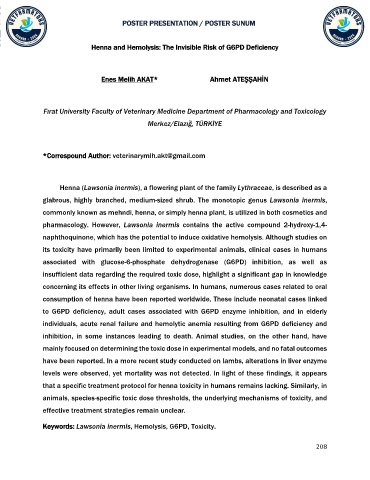Page 211 - congress
P. 211
POSTER PRESENTATION / POSTER SUNUM
Henna and Hemolysis: The Invisible Risk of G6PD Deficiency
Enes Melih AKAT* Ahmet ATEŞŞAHİN
Fırat University Faculty of Veterinary Medicine Department of Pharmacology and Toxicology
Merkez/Elazığ, TÜRKİYE
*Correspound Author: veterinarymlh.akt@gmail.com
Henna (Lawsonia inermis), a flowering plant of the family Lythraceae, is described as a
glabrous, highly branched, medium-sized shrub. The monotopic genus Lawsonia inermis,
commonly known as mehndi, henna, or simply henna plant, is utilized in both cosmetics and
pharmacology. However, Lawsonia inermis contains the active compound 2-hydroxy-1,4-
naphthoquinone, which has the potential to induce oxidative hemolysis. Although studies on
its toxicity have primarily been limited to experimental animals, clinical cases in humans
associated with glucose-6-phosphate dehydrogenase (G6PD) inhibition, as well as
insufficient data regarding the required toxic dose, highlight a significant gap in knowledge
concerning its effects in other living organisms. In humans, numerous cases related to oral
consumption of henna have been reported worldwide. These include neonatal cases linked
to G6PD deficiency, adult cases associated with G6PD enzyme inhibition, and in elderly
individuals, acute renal failure and hemolytic anemia resulting from G6PD deficiency and
inhibition, in some instances leading to death. Animal studies, on the other hand, have
mainly focused on determining the toxic dose in experimental models, and no fatal outcomes
have been reported. In a more recent study conducted on lambs, alterations in liver enzyme
levels were observed, yet mortality was not detected. In light of these findings, it appears
that a specific treatment protocol for henna toxicity in humans remains lacking. Similarly, in
animals, species-specific toxic dose thresholds, the underlying mechanisms of toxicity, and
effective treatment strategies remain unclear.
Keywords: Lawsonia inermis, Hemolysis, G6PD, Toxicity.
208

